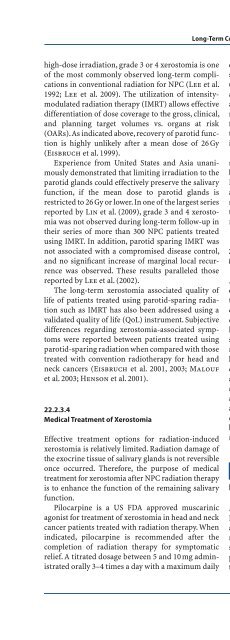Familial Nasopharyngeal Carcinoma 6
Familial Nasopharyngeal Carcinoma 6
Familial Nasopharyngeal Carcinoma 6
- No tags were found...
Create successful ePaper yourself
Turn your PDF publications into a flip-book with our unique Google optimized e-Paper software.
Long-Term Complication in the Treatment of <strong>Nasopharyngeal</strong> <strong>Carcinoma</strong> 279high-dose irradiation, grade 3 or 4 xerostomia is oneof the most commonly observed long-term complicationsin conventional radiation for NPC (Lee et al.1992; Lee et al. 2009). The utilization of intensitymodulatedradiation therapy (IMRT) allows effectivedifferentiation of dose coverage to the gross, clinical,and planning target volumes vs. organs at risk(OARs). As indicated above, recovery of parotid functionis highly unlikely after a mean dose of 26 Gy(Eisbruch et al. 1999).Experience from United States and Asia unanimouslydemonstrated that limiting irradiation to theparotid glands could effectively preserve the salivaryfunction, if the mean dose to parotid glands isrestricted to 26 Gy or lower. In one of the largest seriesreported by Lin et al. (2009), grade 3 and 4 xerostomiawas not observed during long-term follow-up intheir series of more than 300 NPC patients treatedusing IMRT. In addition, parotid sparing IMRT wasnot associated with a compromised disease control,and no significant increase of marginal local recurrencewas observed. These results paralleled thosereported by Lee et al. (2002).The long-term xerostomia associated quality oflife of patients treated using parotid-sparing radiationsuch as IMRT has also been addressed using avalidated quality of life (QoL) instrument. Subjectivedifferences regarding xerostomia-associated symptomswere reported between patients treated usingparotid- sparing radiation when compared with thosetreated with convention radiotherapy for head andneck cancers (Eisbruch et al. 2001, 2003; Maloufet al. 2003; Henson et al. 2001).22.2.3.4Medical Treatment of XerostomiaEffective treatment options for radiation-inducedxerostomia is relatively limited. Radiation damage ofthe exocrine tissue of salivary glands is not reversibleonce occurred. Therefore, the purpose of medicaltreatment for xerostomia after NPC radiation therapyis to enhance the function of the remaining salivaryfunction.Pilocarpine is a US FDA approved muscarinicagonist for treatment of xerostomia in head and neckcancer patients treated with radiation therapy. Whenindicated, pilocarpine is recommended after thecompletion of radiation therapy for symptomaticrelief. A titrated dosage between 5 and 10 mg administratedorally 3–4 times a day with a maximum dailydose of 30 mg have been shown effective for increasingsalivary output and symptomatic reduction(Johnson et al. 1993; LeVeque et al. 1993; Rieke etal. 1995; Hamlar et al. 1996). The use of pilocarpineafter IMRT for managing mild to moderate xerostomiahas not been thoroughly investigated. However,for those whose dose to parotid glands exceeds thetolerance, and who have developed xerostomia, medicaltreatment should be considered.The use of pilocarpine treatment may cause substantialside effects including excessive perspiration,bowel and bladder irritation, and hot sensation.Furthermore, the use of pilocarpine during radiotherapywith an intention to reduce the probability andseverity of xerostomia has not been proven effective,thus is not routinely recommended (Jacobs and vander Pas 1996; Warde et al. 2002; Fisher et al. 2003).22.2.3.5Management of Infection and Dental CariesAs mentioned above, oral candidiasis is a commonlyobserved complication of xerostomia during radiationtherapy for head and neck cancer. However, the frequencyof candidiasis in long-term follow-up after thecompletion of radiation is not as frequent. In addition,long-term use of antifungal agents is usually not necessary.Once occurred, oral rinse using Nystatin is recommended,and systemic antifungal therapy such asketaconazole is usually not indicated unless refractorycandidiasis is observed. Frequent dental examinationand preventative treatment scheduled every 3–6 monthsand maintenance of oral hygiene are important in managementof infection and preventing dental caries. Inaddition, smoking cessation, low sugar diet, avoidingcaffeinated drinks, frequent teeth brushing using softbristle toothbrush, and antiseptic mouth wash canreduce the risk of infection and dental caries.22.3Hearing DeficitA high dose of radiation is needed to eradicate NPC.However, the proximity of the nasopharynx to theauditory organ subjects NPC patients who receiveradiation therapy to risks of conductive and/orsensorineural hearing loss. Patients with NPC maypresent with unilateral hearing loss from serous otitismedia as a result of the blockage of one of the











